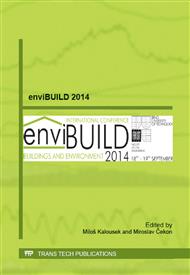p.150
p.154
p.158
p.162
p.167
p.171
p.175
p.183
p.187
Advanced Thermal Performance Analysis of Thermal Break Element Applied in Balcony Slab
Abstract:
Thermal performance of any building component is the result not only of its thermophysical properties but also of a way of final installation and connections altogether of their all elements. In addition, thermal leakage and bridging in buildings can eventually contribute to a multitude of problems. The thermal bridge is the place in the building envelope through which heat transfer has a multi-dimensional nature. That is why in recent studies, the issue of heat transfer phenomena in the building components is considered as a multi-dimensional more frequently. One of the specific details that create thermal leakage is located in balcony slabs. This paper is focused on detailed analysis of thermal performance of thermal break element applied in balcony slab with relation to the thermal aspects of wall building envelope. Particular cases of commonly used balcony systems in buildings are observed related to multi-dimensional and parametric approach of modeling. As result of analyzed thermal aspects, such as importance of building envelope type and its thermal performance, variations of thermal properties, are presented as study findings that affected thermal bridges magnitude and resultant thermal performance of balcony slab detail.
Info:
Periodical:
Pages:
167-170
Citation:
Online since:
October 2014
Authors:
Keywords:
Price:
Сopyright:
© 2014 Trans Tech Publications Ltd. All Rights Reserved
Share:
Citation:


